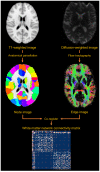Network Efficiency Mediates the Relationship Between Vascular Burden and Cognitive Impairment: A Diffusion Tensor Imaging Study in UK Biobank
- PMID: 32390549
- PMCID: PMC7610498
- DOI: 10.1161/STROKEAHA.119.028587
Network Efficiency Mediates the Relationship Between Vascular Burden and Cognitive Impairment: A Diffusion Tensor Imaging Study in UK Biobank
Abstract
Background and Purpose- Cerebrovascular disease contributes to age-related cognitive decline, but the mechanisms underlying this phenomenon remain incompletely understood. We hypothesized that vascular risk factors would lead to cognitive impairment through the disruption of brain white matter network efficiency. Methods- Participants were 19 346 neurologically healthy individuals from UK Biobank that underwent diffusion MRI and cognitive testing (mean age=62.6). Global efficiency, a measure of network integration, was calculated from white matter networks constructed using deterministic diffusion tractography. First, we determined whether demographics (age, sex, ethnicity, socioeconomic status, and education), vascular risk factors (hypertension, hypercholesterolemia, diabetes mellitus, smoking, body mass index), and white matter hyperintensities were related to global efficiency using multivariate linear regression. Next, we used structural equation modeling to model a multiple regression. The dependent variable was a latent cognition variable using all cognitive data, while independent variables were a latent factor including all vascular risk factors (vascular burden), demographic variables, white matter hyperintensities, and global efficiency. Finally, we used mediation analysis to determine whether global efficiency explained the relationship between vascular burden and cognition. Results- Hypertension and diabetes mellitus were consistently associated with reduced global efficiency even after controlling for white matter hyperintensities. Structural equation models revealed that vascular burden was associated with cognition (P=0.023), but not after adding global efficiency to the model (P=0.09), suggesting a mediation effect. Mediation analysis revealed a significant indirect effect of global efficiency on cognition through vascular burden (P<0.001), suggesting a partial mediation effect. Conclusions- Vascular burden is associated with reduced global efficiency and cognitive impairment in the general population. Network efficiency partially mediates the relationship between vascular burden and cognition. This suggests that treating specific risk factors may prevent reductions in brain network efficiency and preserve cognitive functioning in the aging population.
Keywords: body mass index; cerebrovascular disease; diffusion tensor imaging; risk factors; stroke.
Conflict of interest statement
HSM reports personal fees from BIBA outside the present study.
Figures


References
-
- Pantoni L. Cerebral small vessel disease: From pathogenesis and clinical characteristics to therapeutic challenges. Lancet Neurol. 2010;9:689–701. - PubMed
-
- van Leijsen EM, Tay J, van Uden IW, Kooijmans EC, Bergkamp MI, van der Holst HM, et al. Memory decline in elderly with cerebral small vessel disease explained by temporal interactions between white matter hyperintensities and hippocampal atrophy. Hippocampus. 2019;29:500–510. - PubMed
-
- Wardlaw JM, Smith C, Dichgans M. Small vessel disease: Mechanisms and clinical implications. Lancet Neurol. 2019;18:684–696. - PubMed
-
- Laurent S, Boutouyrie P. The structural factor of hypertension: Large and small artery alterations. Circ Res. 2015;116:1007–1021. - PubMed
-
- Tuladhar AM, Tay J, van Leijsen E, Lawrence AJ, van Uden IWM, Bergkamp M, et al. Structural network changes in cerebral small vessel disease. J Neurol Neurosur Psychiatry. 2020;91:196–203. - PubMed

